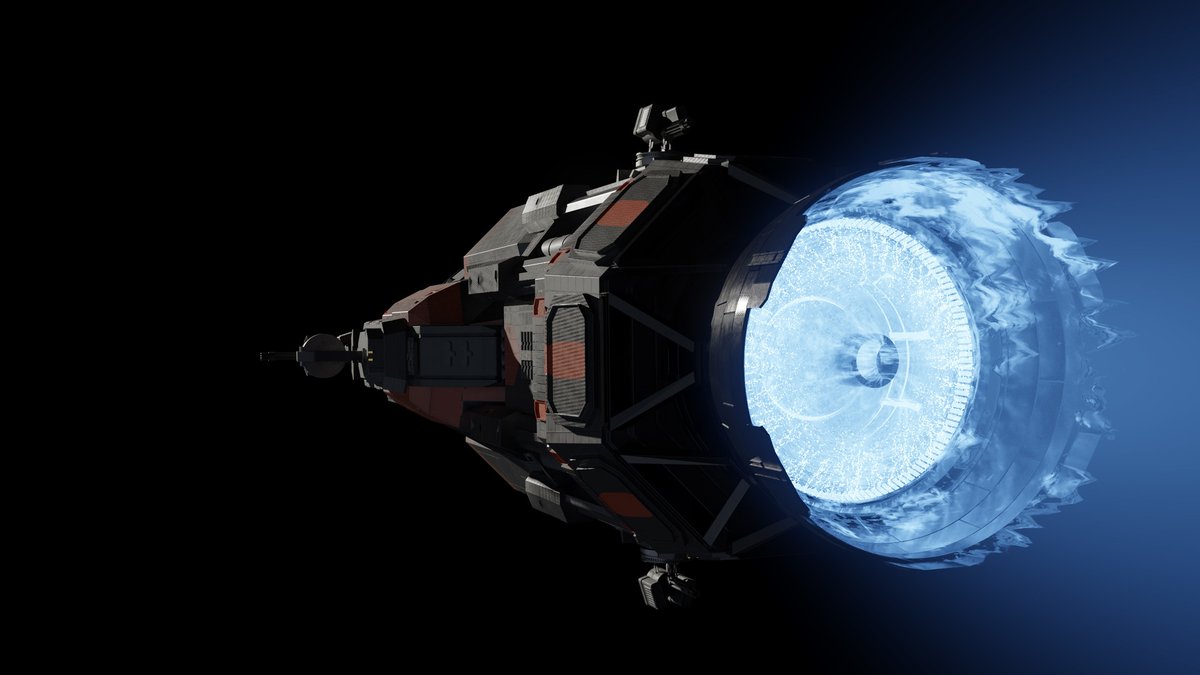So we know how we’re going to shoot through space at a few hundred times the speed of light. Humanity has developed hyperdrive, a system that allows movement through the universe’s crumpled-up dimensions, greatly reducing the distance required to move between points in space.
But like I said in the last post, that still means you need conventional engines to actually get moving. The faster you go, the faster your FTL speed.
But not all engines are built the same, and not all engines will be applicable in all situations. For example, while I definitely wanted big interstellar ships to use torchdrives, theoretical and insanely powerful nuclear rockets, such engines would not be useful for taking off from most planets since, you know… megatons of nuclear exhaust.

The thing to remember is that, to our understanding, there are three general types of rocket engines.
High thrust, low exhaust velocity. This is the kind of thing most of us think about when we hear “rocket.” It’s also the most common type of rocket we can build right now. Those big building-sized rockets that push payloads into orbit are absolute beasts and put out a LOT of force to push things out of the atmosphere… but they get TERRIBLE milage. Once you run out of fuel, you’re going to be moving relatively slowly.
Low thrust, high exhaust velocity. This is a newer idea, but one that has already been implemented. Scientists have built, and used, something called an ion drive. It takes a gas like xenon, charges it, and uses electrical fields to shoot it out the back of the ship or satellite. But the thrust is MINISCULE. You’d never be able to use it to lift off of a planet, for example. The engine has to stay on for DAYS or weeks to give the ship any appreciable change in speed, too. However, the fuel consumption is tiny and can be kept going for weeks or months, and the resulting speed change can be ENORMOUS. If you’re not in a big rush, these kinds of rockets are actually great if you don’t mind taking days to get to speed, but you can end up going REALLY fast in the long-term. Some nuclear-powered engines are like this, too.
High thrust, high exhaust velocity. This is the goal. This is what you want in a rocket. This is a monstrous nuclear-exhaust beast that puts out gigatons of energy. Sadly… we don’t know how to build these things. Yet. But pretty much every proposal is some kind of nuclear-powered rocket.
Another thing to understand is the concept of both the rocket equation and delta-V.

The rocket equation is a way to figure out how much a ship can alter its speed with a given amount of fuel. Wanna go faster? You need fuel, but you also need more fuel to push the fuel you need to go faster… and so on and so forth, which is why engineers REALLY like it when a rocket is not fuel efficient. So the bigger percentage of your ship is fuel, the faster you end up going. That’s where delta-V comes in. That is the number for a given ship, using a given amount of fuel, with a specific engine.
So when trying to figure out what kind of engine to use on any given ship, you need to figure out the ship’s purpose. Does it need to break free of a gravity well? Will it only operate in space? How fast must the ship eventually move in order to achieve its mission objectives?
Let’s say we had a ship with a nice nuclear-thermal rocket (NRT) that could accelerate at 1G (9.81 m/s^2) and had a delta-V of 120 km/s. It would take said ship a little over three hours to get to full speed. At 120 km/s, you could get to the moon in about an hour. Mars at average distance? You could cover those 225 million kilometers in 21 days.
But remember that delta-V is the TOTAL speed change. So if we burn through all our fuel, we now have NO WAY to stop when we get to where we need to go. So if we’re going to Mars, the only way we’re stopping is by crashing into the planet.

Think of delta-V as a “speed budget.” You need to figure out what maneuvers you need to make. For our hypothetical Mars mission, we need four major maneuvers: get going to Mars, slow down, then accelerate back to Earth and slow down once we get to Earth again. It would be tempting to just split our delta-V into four, but in the real world, engineers like to have something to fall back on, so instead of each major maneuver being 30 km/s worth of delta-V, maybe we just use 25 km/s. That’s still Earth to Mars in 104 days, which is a LOT better than the 9 months it usually takes with a Hohmann transfer orbit, and it gives us an extra 20 km/s for other things like establishing orbit, course corrections, etc.
Now, if we had infrastructure in orbit around Mars for refueling, we could either spend more delta-V on speed to cut our travel time down or spend the same and carry more cargo. But that’s for another article.
Generally, ships in Endeavors fall into three general categories: shuttles, interplanetary, and interstellar vessels.

Shuttles further come in two general types: surface-to-orbit vessels and ship shuttles, or vessels designed to ferry people and goods between relatively close locations in space. These ships use a combination of chemical rockets and magnetoplasmadynamic engines to accelerate their exhaust to much higher speed than normal without having to rely on nuclear propulsion. These plasma drives, as they are often called, are also great for maneuvering thrusters onboard larger ships.
If a ship is designed to ONLY operate within a single star system, it will use plasma drives too since they’re low-maintenance and don’t flood space with hard radiation, something you REALLY want to avoid near populated worlds. These ships have a relatively low delta-V, but because they can make hyperspace jumps, they can travel across a star system in a matter of minutes or hours.
Interstellar ships, though? These have torchdrives. Full-on proton fusion rockets with delta-V in the thousands of kilometers per second. This allows them to reach speeds that translate as hundreds of times faster than light and allow them to cross the gulf between adjacent star systems in a few days. While all ships are closely monitored since they’re basically missiles, ships with torchdrives are regulated out the wazoo. A single torchdrive-equipped ship, even with a small fuel supply, could become a multi-megaton kinetic kill vehicle that could easily wipe out a city. Aside from the impracticality of having a separate engine for landing on a planet, this is why shuttles are important. Because no government wants a ship with a continuously firing nuclear weapon in its butt ANYWHERE near the surface of their world.
And that’s what’s getting our heroes in Endeavors to their destinations. And now you know…





